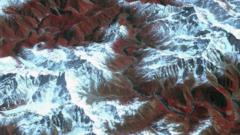Chinese authorities have officially begun the construction of a massive hydropower dam on the Yarlung Tsangpo River in Tibet, a project that is poised to be the largest of its kind globally. Premier Li Qiang inaugurated the construction on Saturday, amidst rising apprehensions from neighboring countries, particularly India and Bangladesh, concerning its potential adverse effects on the millions living along the river downstream.
This colossal endeavor, termed the Motuo Hydropower Station, comes with a price tag estimated at 1.2 trillion yuan (approximately $167 billion). While Chinese officials assure that the project will prioritize ecological integrity and local economic growth, critics warn of the dangers it could pose to communities and ecosystems in the areas reliant on the Yarlung Tsangpo.
The river traverses Tibetan territory before flowing into India’s Arunachal Pradesh and Assam states and finally into Bangladesh, where it merges with the Siang, Brahmaputra, and Jamuna rivers. Concerns have been raised that the dam will empower China to manipulate the river's flow, effectively threatening the economies and livelihoods of millions in downstream nations. A report by the Lowy Institute underscored how control over these vital water resources grants China significant leverage over India.
Pema Khandu, Chief Minister of Arunachal Pradesh, voiced fears that the dam could result in devastating water shortages in the Siang and Brahmaputra basins, substantially threatening the indigenous tribes' way of life. He described the situation as dire, warning that unexpected water releases from the dam could lead to catastrophic flooding, wreaking havoc on agricultural land and endangering lives.
India’s Ministry of External Affairs has previously addressed these concerns with China, pressing for transparency and consultation regarding major dam projects that could harm downstream interests. In response, India has planned the construction of its own hydropower dam on the Siang River to serve as a countermeasure against flooding that might occur due to China's manipulations.
Bangladesh has echoed similar worries over the dam's implications on its water supply and ecology, reaching out to China for more detailed information.
The Yarlung Tsangpo River, running through a famously deep canyon and notably featuring a section known as "the Great Bend", is a focal point for China's exploration of hydropower development. Authorities plan to construct extensive tunnels through the Namcha Barwa mountain to redirect river flows, aiming to install a series of cascading power stations designed to export electricity while meeting local demands.
China's strategic focus on such hydropower projects is part of a broader energy policy dubbed "xidiandongsong," which aims to channel electricity from the developing western regions to the energy-hungry eastern cities. Despite government claims that these projects benefit Tibetans by providing clean energy and reducing pollution, critics argue that it exemplifies Beijing's exploitation of Tibetan land and resources.
Activism against these projects has been met with severe crackdowns, as seen in recent years when protests against another dam saw hundreds of Tibetans arrested and injured during confrontations with authorities. Environmental alarm bells ring over the potential flooding of ecologically sensitive areas and the risks involved in constructing dams on seismic fault lines within the region.




















